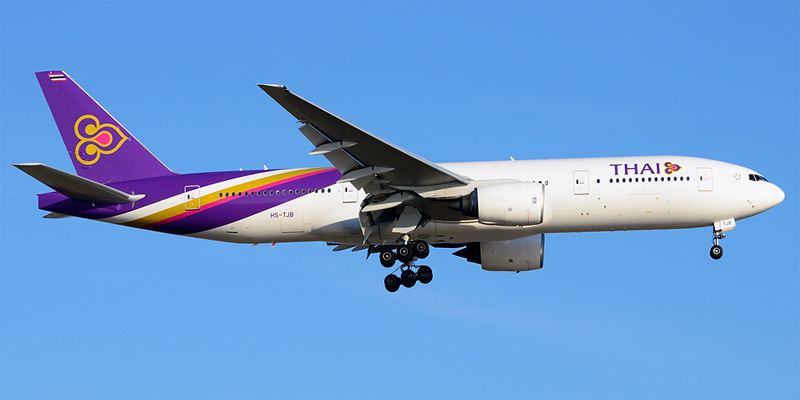
777-200 777-300 for Lease ACMI Sale aircraft engines for Lease ACMI Sale. In 1997, we added the 1st Boeing 777-200ER to our fleet. The -200ER is the world's biggest twin-jet, with the largest landing gear of all commercial aircraft types. Nowadays, we've got 15 of these 'triple sevens' flying around the world, so you just might fly in one of these aircraft to Dubai, Quito, Guayaquil or Osaka (destinations. The basic 777-200 as launched in October 1990 was offered in two versions, the basic 777-200 (initially A-Market) and the increased weight longer range 777-200IGW (Increased Gross Weight, initially B-Market). The IGW has since been redesignated 777-200ER. After the original model, Boeing developed an increased gross weight variant of the 777-200 with greater range and payload capability. Initially named 777-200IGW, the 777-200ER first flew on October 7, 1996, received FAA and JAA certification on January 17, 1997, and entered service with British Airways on February 9, 1997.
This article is part of the Why it Failed series at Aeronautics, which discusses aircraft and spacecraft that didn't take off as well as they were expected to. Read more from this series here.
United Boeing 777 200 Hawaii
Boeing's latest technological marvel was unveiled in the early 2000s, a time when airlines were opening ambitious new long-haul routes to unfathomably far destinations. The aircraft provided a way for airlines to operate some of the world's largest routes, while still maintaining the efficiency of a twin-engine configuration, something the competing Airbus A340-500 did not have. Boeing intended the aircraft to operate routes such as Los Angeles to Singapore, New York to Johannesburg and London to Perth, but none of the manufacturer's intended routes ever took shape. The aircraft seemed to miss its mark.
Initially, the 777-200LR was reasonably successful, with orders from several major carriers, including 10 aircraft for Delta Air Lines and 10 aircraft for Emirates. When it entered service in 2006 with Pakistan International Airlines, it wasn't swamped with orders, but looked like it had the potential to gain more customers. However, Boeing's long-awaited orders never came. A few orders trickled in from various airlines, but nothing over 10 aircraft, and no additional orders from airlines that had already received the plane.
The 777-200LR's main issue was that it's range was too long. The plane wasn't viable on shorter routes due to the weight of it's huge fuel tanks, and steadily rising fuel prices made it difficult to start the ultra-long-haul routes it was intended for. Currently, the aircraft operates just a small handful of such routes, including Doha to Auckland with Qatar Airways and Atlanta to Johannesburg with Delta Air Lines. The aircraft's efficiency on long-haul routes has made it popular with airlines, however it has largely been replaced with smaller aircraft on the world's longest routes, such as the Airbus A350, which operates the world's longest commercial flight, and the Boeing 787, which operates the world's third-longest commercial flight. The 777 has largely sat on the sidelines operating shorter but higher-demand routes that could easily be operated by cheaper aircraft with shorter ranges.
Currently, 60 Boeing 777-200LRs have been produced, with airlines operating 50 and the remaining 10 belonging to governments and private customers. One aircraft is currently in Boeing's order backlog, belonging to Turkmenistan Airlines, which it will likely use to serve popular destinations in the United Kingdom, routes within the operating range of the smaller Boeing 737 and 757. The aircraft will likely not receive any future orders, as customers are more likely to choose more modern or smaller aircraft such as the Boeing 777-8 or 787-9.

777-200 777-300 for Lease ACMI Sale aircraft engines for Lease ACMI Sale. In 1997, we added the 1st Boeing 777-200ER to our fleet. The -200ER is the world's biggest twin-jet, with the largest landing gear of all commercial aircraft types. Nowadays, we've got 15 of these 'triple sevens' flying around the world, so you just might fly in one of these aircraft to Dubai, Quito, Guayaquil or Osaka (destinations. The basic 777-200 as launched in October 1990 was offered in two versions, the basic 777-200 (initially A-Market) and the increased weight longer range 777-200IGW (Increased Gross Weight, initially B-Market). The IGW has since been redesignated 777-200ER. After the original model, Boeing developed an increased gross weight variant of the 777-200 with greater range and payload capability. Initially named 777-200IGW, the 777-200ER first flew on October 7, 1996, received FAA and JAA certification on January 17, 1997, and entered service with British Airways on February 9, 1997.
This article is part of the Why it Failed series at Aeronautics, which discusses aircraft and spacecraft that didn't take off as well as they were expected to. Read more from this series here.
United Boeing 777 200 Hawaii
Boeing's latest technological marvel was unveiled in the early 2000s, a time when airlines were opening ambitious new long-haul routes to unfathomably far destinations. The aircraft provided a way for airlines to operate some of the world's largest routes, while still maintaining the efficiency of a twin-engine configuration, something the competing Airbus A340-500 did not have. Boeing intended the aircraft to operate routes such as Los Angeles to Singapore, New York to Johannesburg and London to Perth, but none of the manufacturer's intended routes ever took shape. The aircraft seemed to miss its mark.
Initially, the 777-200LR was reasonably successful, with orders from several major carriers, including 10 aircraft for Delta Air Lines and 10 aircraft for Emirates. When it entered service in 2006 with Pakistan International Airlines, it wasn't swamped with orders, but looked like it had the potential to gain more customers. However, Boeing's long-awaited orders never came. A few orders trickled in from various airlines, but nothing over 10 aircraft, and no additional orders from airlines that had already received the plane.
The 777-200LR's main issue was that it's range was too long. The plane wasn't viable on shorter routes due to the weight of it's huge fuel tanks, and steadily rising fuel prices made it difficult to start the ultra-long-haul routes it was intended for. Currently, the aircraft operates just a small handful of such routes, including Doha to Auckland with Qatar Airways and Atlanta to Johannesburg with Delta Air Lines. The aircraft's efficiency on long-haul routes has made it popular with airlines, however it has largely been replaced with smaller aircraft on the world's longest routes, such as the Airbus A350, which operates the world's longest commercial flight, and the Boeing 787, which operates the world's third-longest commercial flight. The 777 has largely sat on the sidelines operating shorter but higher-demand routes that could easily be operated by cheaper aircraft with shorter ranges.
Currently, 60 Boeing 777-200LRs have been produced, with airlines operating 50 and the remaining 10 belonging to governments and private customers. One aircraft is currently in Boeing's order backlog, belonging to Turkmenistan Airlines, which it will likely use to serve popular destinations in the United Kingdom, routes within the operating range of the smaller Boeing 737 and 757. The aircraft will likely not receive any future orders, as customers are more likely to choose more modern or smaller aircraft such as the Boeing 777-8 or 787-9.
However, the 777-200LR wasn't a complete failure. The aircraft serves as the basis for the long-range Boeing 777 Freighter, utilized by freight airlines around the world including FedEx and Lufthansa Cargo. If it weren't for the -200LR's advances in long-range technology, the Freighter variant would have received far fewer orders to date due to working with less range and fewer available destinations to serve.
Boeing 777 200 Seating
All images courtesy of Martin Tietz / Aeronautics Online

